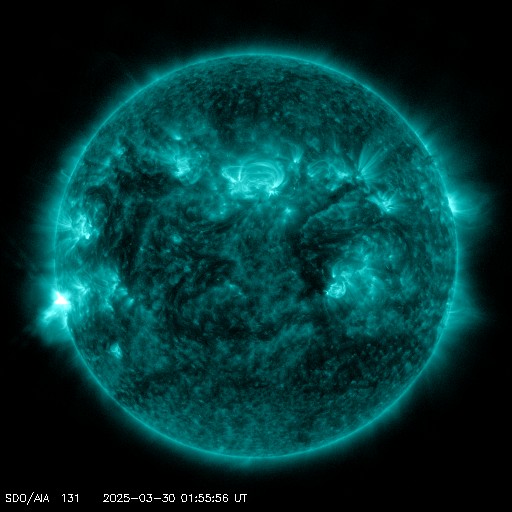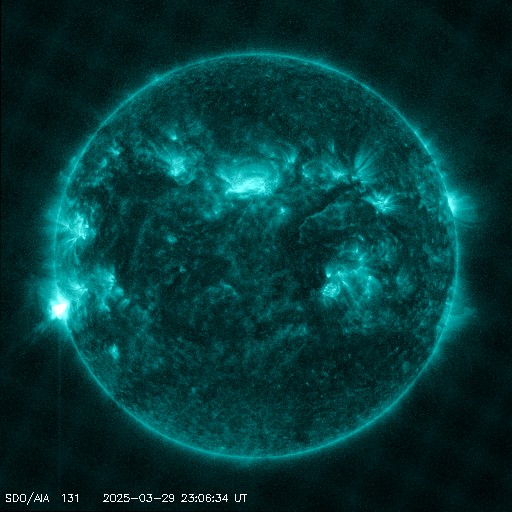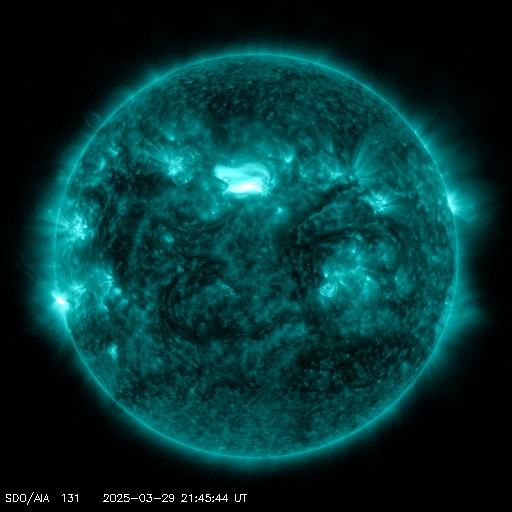Viewing archive of Sunday, 2 May 2010
Solar activity report
Any mentioned solar flare in this report has a scaling factor applied by the Space Weather Prediction Center (SWPC). Because of the SWPC scaling factor, solar flares are reported as 42% smaller than for the science quality data. The scaling factor has been removed from our archived solar flare data to reflect the true physical units.
Report of Solar-Geophysical Activity 2010 May 02 2201 UTCPrepared by the NOAA © SWPC and processed by SpaceWeatherLive.com
Joint USAF/NOAA Report of Solar and Geophysical Activity
SDF Number 122 Issued at 2200Z on 02 May 2010IA. Analysis of Solar Active Regions and Activity from 01-2100Z to 02-2100Z
Solar activity was very low. Only weak B-class activity
was observed. Three new regions were numbered during the period.
Regions 1065 (S32W16) and 1066 (S27E16) formed on the disk as
single, unipolar spot groups. Region 1067 (N23E56) rotated on the
disk as a bi-polar spot group.
IB. Solar Activity Forecast
Solar activity is expected to be very
low to low. C-class activity is likely from Region 1067.
IIA. Geophysical Activity Summary 01-2100Z to 02-2100Z
The geomagnetic field ranged from quiet to major storm levels during
the period. Activity was quiet through about 1100Z when levels
increased to active to minor storming at middle latitudes, with
major storm periods observed at high latitudes. At about 0900Z,
observations from the ACE spacecraft indicated increases in
temperature, density and wind velocity, while the Bz component of
the interplanetary magnetic field showed strong negative incursions
to -20 nT. Wind speeds gradually increased from about 375 km/s to
near 700 km/s by 1645Z. Thereafter, wind speeds leveled out to about
650 km/s, and remained so through the balance of the period. These
signatures were indicative of a co-rotating interaction region in
advance of a recurrent coronal hole high speed wind stream.
IIB. Geophysical Activity Forecast
The geomagnetic field is
expected to be at unsettled to active levels, with isolated minor
storm periods at middle latitudes for days one and two (03 - 04
May). During the same period, high latitudes should expect similar
conditions with isolated major storm periods. This activity is due
to a geoeffective, recurrent coronal hole high speed wind stream. By
day three (05 May), activity is expected to decrease to mostly quiet
to unsettled levels with isolated active periods at middle
latitudes, while high latitudes could see isolated minor storm
periods.
III. Event Probabilities 03 May to 05 May
| Class M | 05% | 05% | 05% |
| Class X | 01% | 01% | 01% |
| Proton | 01% | 01% | 01% |
| PCAF | Green | ||
IV. Penticton 10.7 cm Flux
Observed 02 May 080 Predicted 03 May-05 May 082/084/086 90 Day Mean 02 May 081
V. Geomagnetic A Indices
Observed Afr/Ap 01 May 001/004 Estimated Afr/Ap 02 May 020/030 Predicted Afr/Ap 03 May-05 May 020/035-020/035-015/018
VI. Geomagnetic Activity Probabilities 03 May to 05 May
| A. Middle Latitudes | |||
|---|---|---|---|
| Active | 40% | 40% | 25% |
| Minor storm | 10% | 10% | 05% |
| Major-severe storm | 05% | 05% | 01% |
| B. High Latitudes | |||
|---|---|---|---|
| Active | 45% | 45% | 30% |
| Minor storm | 20% | 20% | 10% |
| Major-severe storm | 10% | 10% | 01% |
All times in UTC
Current data suggests there is a slight possibility for aurora to appear at the following high latitude regions in the near future
Gillam, MB, Whitehorse, YT, Yellowknife, NTFairbanks, AK
Latest news
Latest forum messages
More topicsSupport SpaceWeatherLive.com!
A lot of people come to SpaceWeatherLive to follow the Sun's activity or if there is aurora to be seen, but with more traffic comes higher server costs. Consider a donation if you enjoy SpaceWeatherLive so we can keep the website online!

Latest alerts
02:09 UTC - Solar flare
Moderate M1.54 flare from sunspot region 4048
01:42 UTC - Radio Blackout
Minor R1 radio blackout in progress (≥M1 - current: M1.24)
Saturday, 29 March 2025
23:21 UTC - Solar flare
Moderate M1.91 flare from sunspot region 4048
22:51 UTC - Radio Blackout
Minor R1 radio blackout in progress (≥M1 - current: M1.1)
21:57 UTC - Solar flare
Moderate M1.45 flare from sunspot region 4048
Space weather facts
| Last X-flare | 2025/03/28 | X1.1 |
| Last M-flare | 2025/03/30 | M1.5 |
| Last geomagnetic storm | 2025/03/27 | Kp5 (G1) |
| Spotless days | |
|---|---|
| Last spotless day | 2022/06/08 |
| Monthly mean Sunspot Number | |
|---|---|
| February 2025 | 154.6 +17.6 |
| March 2025 | 127.5 -27.1 |
| Last 30 days | 127.5 -24.7 |





